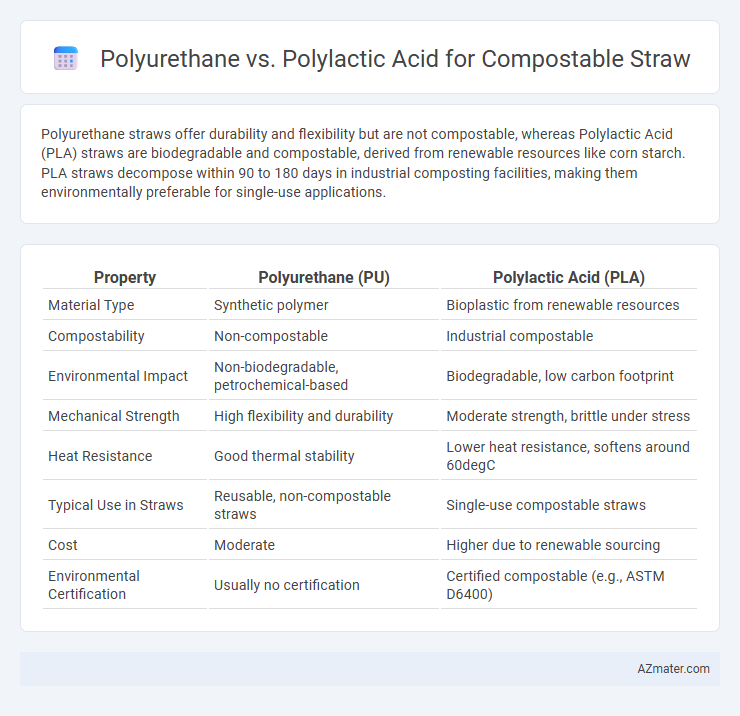Polyurethane straws offer durability and flexibility but are not compostable, whereas Polylactic Acid (PLA) straws are biodegradable and compostable, derived from renewable resources like corn starch. PLA straws decompose within 90 to 180 days in industrial composting facilities, making them environmentally preferable for single-use applications.
Table of Comparison
| Property | Polyurethane (PU) | Polylactic Acid (PLA) |
|---|---|---|
| Material Type | Synthetic polymer | Bioplastic from renewable resources |
| Compostability | Non-compostable | Industrial compostable |
| Environmental Impact | Non-biodegradable, petrochemical-based | Biodegradable, low carbon footprint |
| Mechanical Strength | High flexibility and durability | Moderate strength, brittle under stress |
| Heat Resistance | Good thermal stability | Lower heat resistance, softens around 60degC |
| Typical Use in Straws | Reusable, non-compostable straws | Single-use compostable straws |
| Cost | Moderate | Higher due to renewable sourcing |
| Environmental Certification | Usually no certification | Certified compostable (e.g., ASTM D6400) |
Introduction to Compostable Straws
Compostable straws are eco-friendly alternatives designed to reduce plastic pollution by breaking down naturally in compost environments. Polyurethane straws offer durability and flexibility but may have limited compostability due to synthetic components. Polylactic acid (PLA) straws, derived from renewable resources like corn starch, provide a fully compostable option that decomposes efficiently under industrial composting conditions.
What is Polyurethane?
Polyurethane is a versatile polymer commonly used in manufacturing flexible and rigid materials, known for its durability and resistance to abrasion and chemicals. Composed of organic units joined by carbamate (urethane) links, it is typically derived from petroleum-based polyols and diisocyanates. While polyurethane provides strong mechanical properties, it is not inherently biodegradable or compostable, making it less suitable for eco-friendly straw alternatives compared to polylactic acid (PLA), which is bio-based and compostable.
What is Polylactic Acid (PLA)?
Polylactic Acid (PLA) is a biodegradable thermoplastic derived from renewable resources like corn starch or sugarcane, making it an eco-friendly alternative for compostable straws. PLA offers excellent clarity, rigidity, and compostability under industrial conditions, breaking down into water and carbon dioxide within 90 to 180 days. Compared to polyurethane, PLA provides a sustainable solution with lower environmental impact, ideal for single-use straw applications where biodegradability and reduced plastic pollution are priorities.
Manufacturing Process: Polyurethane vs PLA
Polyurethane straws are produced through a chemical reaction between polyols and diisocyanates, resulting in a durable, flexible polymer formed via a controlled polymerization process that requires industrial equipment and hazardous solvent management. In contrast, polylactic acid (PLA) straws are manufactured from renewable biomass sources like corn starch or sugarcane through fermentation to produce lactic acid, followed by polymerization into PLA bioplastic using extrusion or injection molding techniques. PLA production is considered more environmentally friendly due to its bio-based origin and biodegradability, while polyurethane manufacturing involves petrochemical inputs and generates more chemical waste.
Biodegradability and Compostability Compared
Polyurethane (PU) straws are generally not biodegradable and require industrial processing for partial breakdown, whereas polylactic acid (PLA) straws are derived from renewable resources and exhibit true compostability under industrial composting conditions. PLA straws biodegrade into water, carbon dioxide, and biomass within 90 to 180 days in a composting facility, aligning with ASTM D6400 standards, while PU straws persist in the environment and contribute to microplastic pollution. The compostability advantage of PLA supports circular economy goals, making it a preferable material for eco-friendly disposable straws.
Performance and Durability of Both Materials
Polyurethane straws offer superior flexibility and resistance to moisture, enhancing durability during use, while polylactic acid (PLA) straws excel in biodegradability and compostability under industrial composting conditions. PLA's performance can diminish in prolonged exposure to liquids, leading to potential breakage, whereas polyurethane maintains structural integrity but lacks full compostability. The choice between these materials hinges on balancing environmental impact with functional longevity, where PLA supports eco-friendly disposal, and polyurethane provides robust, reusable performance.
Environmental Impact Assessment
Polyurethane straws, derived from petroleum-based polymers, generally exhibit lower biodegradability and contribute to long-term environmental pollution, posing challenges in waste management and landfill accumulation. Polylactic Acid (PLA), a biopolymer sourced from renewable resources like corn starch, demonstrates higher compostability under industrial composting conditions, significantly reducing carbon emissions and landfill volume. Life cycle assessments reveal PLA's superior environmental profile through lower greenhouse gas emissions and enhanced soil biodegradation compared to polyurethane alternatives.
Cost Analysis: Polyurethane vs PLA Straws
Polyurethane straws present higher manufacturing costs due to complex polymer synthesis and specialized production equipment, resulting in a price range of $0.10 to $0.25 per straw. Polylactic acid (PLA) straws benefit from more established bioplastic production methods and lower raw material expenses derived from corn starch, averaging $0.05 to $0.15 per straw. The cost difference impacts scalability and market competitiveness, with PLA straws offering more cost-effective solutions for large-scale compostable straw production.
Regulatory and Certification Landscape
Polyurethane compostable straws often face challenges meeting stringent regulatory standards due to synthetic chemical compositions, whereas polylactic acid (PLA) straws generally comply with widely recognized certifications such as ASTM D6400 and EN 13432 for industrial compostability. PLA benefits from extensive certification by organizations like the Biodegradable Products Institute (BPI) and TUV Austria, facilitating market acceptance and regulatory approval in regions including the EU and North America. Regulatory frameworks emphasize biodegradability, non-toxicity, and compostability timeframes, where PLA's bio-based origin provides a competitive advantage over polyurethane in achieving compliance.
Which Compostable Straw Material is Best?
Polylactic Acid (PLA) is widely regarded as the best compostable straw material due to its renewable origin from cornstarch and ability to biodegrade effectively under industrial composting conditions. Polyurethane, although durable and flexible, generally lacks compostability and can persist in the environment, making it less suitable for eco-friendly disposable straw applications. Prioritizing PLA straws supports sustainability goals through reduced plastic pollution and improved composting efficiency.

Infographic: Polyurethane vs Polylactic Acid for Compostable Straw
 azmater.com
azmater.com